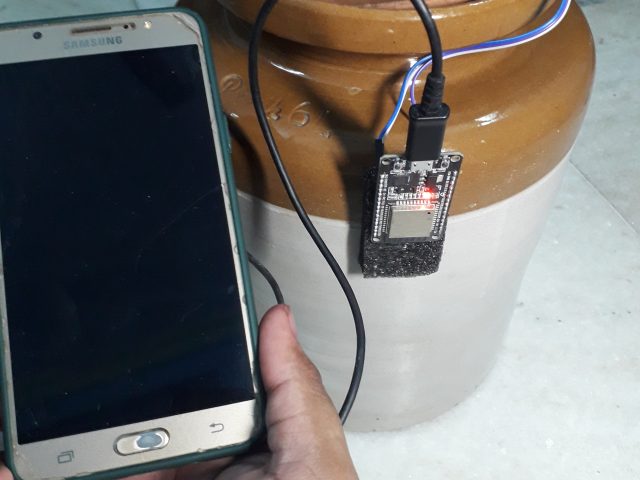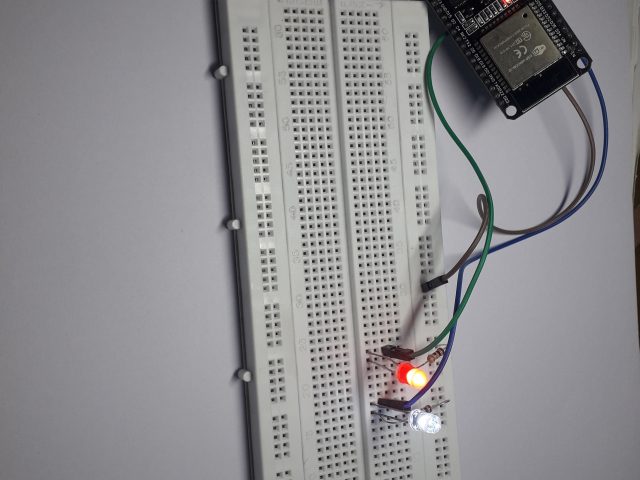Hello Everyone
Life is too short and the personal satisfaction can be achieved by having serious fun while creating original and genuine products which make peoples life better
The ability to estimate more accurately, the future of wireless technology and with the help of software project planning also product development approaches such as Agile let us create a great product as well as the selfless pursuit to make a positive difference to peoples life
Selected Projects
Wireless system to monitor pickling jars with an ESP32 board

The goal of the project is to build a wireless system that can monitor the pickling jar by displaying live reading from a DHT11 sensor on a web server that displays the temperatures in Celcius and Fahrenheit also humidity, plus, a clock with the current day, month, year as well as, display the comment which indicates whether the current temperature is suitable for the fermentation process
For pickling vegetables such as sauerkraut, cucumber pickle, Jalapeno pickle temperature plays a vital role to create the quality of the pickle as it is a live probiotics bacteria that is good for the gut health and the ideal range for the fermentation process is 12 degrees Celcius,53.6 Fahrenheit to 29 degrees Celcius, 84 Fahrenheit, if the temperature increase above the 29 degrees Celcius, 84 Fahrenheit it can damage the vegetable usually, the hot climate countries such as India, Saudi Arabia, Dubai in summer months temperature can shoot up to 44-degree Celcius or even more in some countries so, in hot climate countries it literally becomes impossible to ferment any vegetable
With the help of this wireless system the people who like to ferment the vegetable in their houses to improve their gut health in hot climate countries, the system will make it easier for them to monitor temperature wirelessly and let them record the temperature inside an earthen jar and outside the jar
The GUI for the project is built with help of CSS, HTML, and javascript, moreover, to update the live reading from the DHT11 sensor javascript is used furthermore, javascript is also used to update current, date, month, year, time, AM/PM indicator and a comment that indicate whether a current temperature is suitable for the fermentation process, in addition, an external site called unsplash.com is used to change the background image of the GUI

The goal of the project is to build a wireless system that can monitor the pickling jar by displaying live reading from a DHT11 sensor on a web server that displays the temperatures in Celcius and Fahrenheit also humidity, plus, a clock with the current day, month, year as well as, display the comment which indicates whether the current temperature is suitable for the fermentation process
For pickling vegetables such as sauerkraut, cucumber pickle, Jalapeno pickle temperature plays a vital role to create the quality of the pickle as it is a live probiotics bacteria that is good for the gut health and the ideal range for the fermentation process is 12 degrees Celcius,53.6 Fahrenheit to 29 degrees Celcius, 84 Fahrenheit, if the temperature increase above the 29 degrees Celcius, 84 Fahrenheit it can damage the vegetable usually, the hot climate countries such as India, Saudi Arabia, Dubai in summer months temperature can shoot up to 44-degree Celcius or even more in some countries so, in hot climate countries it literally becomes impossible to ferment any vegetable
With the help of this wireless system the people who like to ferment the vegetable in their houses to improve their gut health in hot climate countries, the system will make it easier for them to monitor temperature wirelessly and let them record the temperature inside an earthen jar and outside the jar
The GUI for the project is built with help of CSS, HTML, and javascript, moreover, to update the live reading from the DHT11 sensor javascript is used furthermore, javascript is also used to update current, date, month, year, time, AM/PM indicator and a comment that indicate whether a current temperature is suitable for the fermentation process, in addition, an external site called unsplash.com is used to change the background image of the GUI
Switching LEDs ON and OFF wirelessly with ESP32board

The goal of the project is to understand the Client and
Server-based model and to explore the HTTP protocol
Practically by learning the process of wirelessly controlling and monitoring electronic devices from anywhere in the world and also authenticating an ESP32webser with encoded username and password text
The major benefit of controlling LEDs or any other device virtually with ESP32 web-server will be easier for the end-user to control any device virtually without a local network, moreover, the logic which is used in this project can also be applied to the home appliances to control and monitor from anywhere in the world
The GUI for the project is built by using CSS and HTML so, that
it can be viewed with any device that is connected to a local
router or any network in the world plus a GET method is used to request a document from the server and for HTTP authentication an online tool called Base64 tool is used simultaneously to access the ESP32 web-server from anywhere in the world an online tool called ngrok is used.
The client(web browser) of the project is connected to the
server by a TELNET which is a TCP/IP protocol that enables the
communication between a local terminal and a remote
terminal

The goal of the project is to understand the Client and
Server-based model and to explore the HTTP protocol
Practically by learning the process of wirelessly controlling and monitoring electronic devices from anywhere in the world and also authenticating an ESP32webser with encoded username and password text
The major benefit of controlling LEDs or any other device virtually with ESP32 web-server will be easier for the end-user to control any device virtually without a local network, moreover, the logic which is used in this project can also be applied to the home appliances to control and monitor from anywhere in the world
The GUI for the project is built by using CSS and HTML so, that
it can be viewed with any device that is connected to a local
router or any network in the world plus a GET method is used to request a document from the server and for HTTP authentication an online tool called Base64 tool is used simultaneously to access the ESP32 web-server from anywhere in the world an online tool called ngrok is used.
The client(web browser) of the project is connected to the
server by a TELNET which is a TCP/IP protocol that enables the
communication between a local terminal and a remote
terminal
Building a custom network topology with python to demonstrate the L2 routing concept

The goal of the project is to build a custom network topology by using Vlan, L2 switch, and two host machines to demonstrate how L2 routing is done practically?
Physical network infrastructure (hardware) require manual configuration and is not flexible enough to manage the network infrastructure on the other hand it is costly to operate
Thus, building custom network topology will help us manage the network efficiently and also increases the flexibility, security, ease to manage resources, greater control over the network, easy to adapt new use cases which emerges from the future
So, to build custom network topology a tool called Mininet(software-defined networking) is used with python
completion:
August 11, 2021
LANGUAGE:
python
TOOLS:
Mininet network emulator (software-defined networking)

The goal of the project is to build a custom network topology by using Vlan, L2 switch, and two host machines to demonstrate how L2 routing is done practically?
Physical network infrastructure (hardware) require manual configuration and is not flexible enough to manage the network infrastructure on the other hand it is costly to operate
Thus, building custom network topology will help us manage the network efficiently and also increases the flexibility, security, ease to manage resources, greater control over the network, easy to adapt new use cases which emerges from the future
So, to build custom network topology a tool called Mininet(software-defined networking) is used with python
Developing DSP algorithms with C

The goal of the project: is to understand the DSP practically while avoiding abstract mathematical theories
The audio signal and ECG signal is recorded in MATLAB and converted into a digital form
The Signal mean, Variance, Standard deviation, DFT, IDFT, and Convolution algorithms are designed and implemented with C programming language on digital data which was generated with MATLAB
A tool called GNUPLOT is used to view and plot the waveforms of the audio signal
Date: January 18, 2020
Language :
C
Tools:
Gnuplot, Matlab

The goal of the project: is to understand the DSP practically while avoiding abstract mathematical theories
The audio signal and ECG signal is recorded in MATLAB and converted into a digital form
The Signal mean, Variance, Standard deviation, DFT, IDFT, and Convolution algorithms are designed and implemented with C programming language on digital data which was generated with MATLAB
A tool called GNUPLOT is used to view and plot the waveforms of the audio signal
Audio files mixing

The project is about mixing different .wav files into a single wav file
To read and write a wav file Resource interchange file format(RIFF) is used
For the project, four .wav is used such as Reggae.wav, African.wav, Piano.wav ,Jazz.wav with sample rate 44100HZ and all the four audio files have the mono channel
A tool called Audacity is used to convert a stereo .wav to mono.wav file
All the four .wav were successfully converted into a single .wav with all elements of each .wav file
Date: October 14, 2020
Language :
C/C++
tools:
Audacity

The project is about mixing different .wav files into a single wav file
To read and write a wav file Resource interchange file format(RIFF) is used
For the project, four .wav is used such as Reggae.wav, African.wav, Piano.wav ,Jazz.wav with sample rate 44100HZ and all the four audio files have the mono channel
A tool called Audacity is used to convert a stereo .wav to mono.wav file
All the four .wav were successfully converted into a single .wav with all elements of each .wav file
Building a custom network topology with python to demonstrate the L3 routing concept

The goal of the project is to build a custom network topology by using
3-L3 routers, two host machines with loopback addresses, and 4 subnets to demonstrate how L3 routing is done virtually with Mininet?
The drawback of L2 routing is that it works only when both the source and destination machine are present in the same subnet but by doing L3 routing we can solve the L2- routing problem and with the help of L3 routing we can send the packet from the source subnet to the destination subnet
Also, the drawback of Physical network infrastructure (hardware) require manual configuration and is not flexible enough to manage the network infrastructure and on the other hand, it is costly to operate
Thus, building custom network topology will help us manage the network efficiently and also increases the flexibility, security, ease to manage resources, greater control over the network, easy to adapt new use cases which emerges from the future
So, to build custom network topology a tool called Mininet(software-defined networking) is used with python
Completion::
September 13, 2021
Language :
Python
Tools:
Mininet network emulator(software-defined networking

The goal of the project is to build a custom network topology by using
3-L3 routers, two host machines with loopback addresses, and 4 subnets to demonstrate how L3 routing is done virtually with Mininet?
The drawback of L2 routing is that it works only when both the source and destination machine are present in the same subnet but by doing L3 routing we can solve the L2- routing problem and with the help of L3 routing we can send the packet from the source subnet to the destination subnet
Also, the drawback of Physical network infrastructure (hardware) require manual configuration and is not flexible enough to manage the network infrastructure and on the other hand, it is costly to operate
Thus, building custom network topology will help us manage the network efficiently and also increases the flexibility, security, ease to manage resources, greater control over the network, easy to adapt new use cases which emerges from the future
So, to build custom network topology a tool called Mininet(software-defined networking) is used with python
